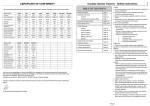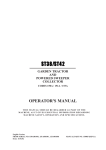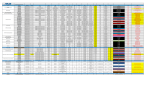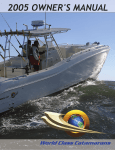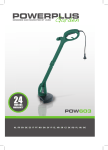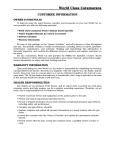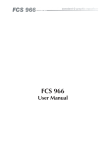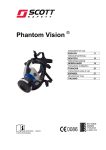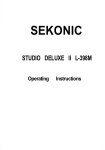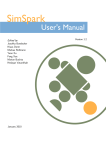Download Westwood W Series Operator`s manual
Transcript
Operator’s Manual W Series Table of contents Safety Instructions 2009.622 Westwood W Series – Safety Instructions Training Page 1 Operating Instructions 1. Read the instructions carefully. Be familiar with controls and the use of equipment. 2. Never allow children or people unfamiliar with these instructions to operate the mower. Safety Page 2 Seat Adjustment Page 3 Ignition Page 3 Choke Page 3 4. The operator or user is responsible for accidents or hazards occurring to other people or their property. Engine Speed Control Page 3 5. Do not carry passengers. RPM Meter Page 3 Hour Meter Page 3 6. All drivers should seek to obtain professional and practical instruction. In addition the following should be noted: Drive Controls Page 4 Moving Off / Reversing Page 4 • The need for care and concentration when working with this machine Stopping Page 4 Parking Page 4 • Control of a machine sliding on a slope; control will not be regained by applying the brake Dump Valve Page 4 • The main reasons for loss of control are: Cutter On/Off Switch Page 5 Transport Lever Page 5 Lights Page 5 Deck lift (manual and dial-a-height) Page 6 Mowing Guide 3. Never mow while people, especially children or pets, are nearby. i. Insufficient wheel grip ii. Driving too fast iii. Operating on steep slopes (max 15º front wheel drive, 25º 4WD) iv. Incorrect load distribution Preparation Mulch Mowing Page 7 High Grass Mulch Deck Page 7 COMBI Deck Page 7 1. Check that the machine complies with all applicable regulations, including those in force when used on the public highway. Engine Maintenance Page 8 2. When mowing, always wear substantial footwear and long trousers. Do not operate when barefoot or with sandals. Battery Maintenance Page 8 Cutter Deck cleaning Page 8 Electric Clutch to Cutter Drive Belt Tension Page 9 Transmission Drive Belt Page 9 Transmission Oil Tank Page 9 Changing Cutter Decks / Deck Drive Belt Routine Maintenance 3. Thoroughly inspect the area where the machine is to be used and remove all stones, sticks, wires and bones or any other foreign objects. 4. WARNING – petrol is highly flammable: • Store fuel in containers specifically designed for this purpose Page 10 • Refuel outdoors only and do not smoke while refuelling To Remove the Seat Box Page 10 Removal of Cutter Deck Page 11 Re-fitting the Cutter Deck Page 11 • Add fuel before starting the engine. Never remove the cap from the fuel tank or add petrol while the engine is running or when engine is hot Steering System Page 12 • If petrol is spilled, do not attempt to start the engine but move the machine away from the area of spillage and avoid creating any source of ignition until petrol vapours have dissipated • Replace the fuel cap securely Troubleshooting Deck Levelling Page 13 Tyres and Wheels Page 14 Cutting Page 15 5. Replace faulty silencers. Engine and Fuel Page 16 Electrical Page 17 6. Before using, always inspect to see that the blades, bolts and cutter assembly are not worn or damaged. Supplementary Instructions Page 18 Specifications: 2WD Page 19 Specifications: 4WD Page 20 Personal Service Record Page 21 Certificate of Conformity Page 22 7. Check the condition of the tyres and ensure that they are inflated to the correct pressures (refer to pages 19 and 20). This is particularly important if the machine is to be taken on the public highway. 8. Check that the mower is in good working order, paying special attention to brakes and steering. 9. Check that all linkages, connections and pivot nuts are secure and that the wheel nuts are tightened correctly. Page 1 Westwood W Series – Operating Instructions Safety 1. Read the instructions carefully. Be familiar with controls and the use of equipment. 2. Do not operate the engine in a confined space where dangerous fumes can collect. 3. Mow only in daylight or in very good artificial light. 4. Before starting the engine, disengage blade and attachment drives and apply the Park Brake. 5. Take care on slopes - maximum 15º for 2WD and 25º on 4WD models. On no account should slopes steeper than 25º be driven on. 6. Remember, there is no such thing as a ‘safe slope’. Travel on grass slopes requires particular care to guard against overturning: •Do not stop or start suddenly when going up or downhill •Engage drive slowly. Always keep the machine in drive when travelling up or down a slope •Machine speed should be kept low on slopes and in tight turns •Stay alert for humps and hollows and other hidden hazards •Avoid mowing across the face of a slope 7. Watch out for traffic when crossing or working near roadways. 8. Stop the blades rotating before crossing roadways. 9. When using the machine, never direct discharge or material towards bystanders or allow anyone near the machine while in operation. 10. Never operate the mower with defective guards, shields or without protective safety devices in place and in good working order. 11. Do not change governor settings to increase the revs of the engine. Operating an engine at excessive speed increases the risk of injury. Cutting Height Adjustment Lever* 12. 13. Before leaving the operator’s position: •Disengage the drive to the cutter blades •Apply the parking brake •Stop the engine and remove the ignition key Always disengage drive, apply the Park Brake, stop the engine and disconnect the spark plug lead or remove the ignition key before: •Cleaning blockages •Checking, cleaning or working on the mower •Refuelling Also: •After striking a foreign object inspect the mower for damage and make any repairs before restarting the machine •If the machine starts to vibrate abnormally, check immediately and call your dealer if necessary 14. Reduce the throttle setting during engine run-out. 15. Never work on the mower when the engine is running. Always: •Use good common sense at all times and to ensure this machine is safe and serviceable fit only original manufacturer’s supplied spares •Inspect the area to be cut, note the position of any stumps, manhole covers, bumps or depressions and avoid them to prevent damaging the blades •Ensure the fuel tank is full before you start the machine. We recommend the use of STANDARD UNLEADED fuel •Disconnect both battery terminals before attempting any work in the engine compartment Never: Drive Pedals Leave the machine running and unattended. Ignition, Throttle Controls and Parking Brake Dashboard Exhaust Fuel Tank Cutter Deck Anti-scalp Wheel Figure 1 Page 2 * Where fitted Westwood W Series – Operating Instructions Seat Adjustment (Figure 2) The seat on your Westwood W Series is adjustable forward and backward to suit the operator. Simply lift the seat latch at the front of the seat and slide the seat forward or backward as appropriate. Always ensure the seat is latched into position before driving off. Ignition (Figure 3) The “key start” controls the ignition and a starter button controls the engine start. The engine cannot be started without the park brake being on. Insert the key and turn, then press the start button, this will activate the starter. To stop the engine, turn the key to the left (having first switched off the cutter). To prevent unauthorised use, always remove the key after use. THE IGNITION SHOULD ALWAYS BE TURNED OFF BEFORE THE MACHINE IS RE-STARTED. Figure 2 Figure 3 NOTE: 4WD models have an additional switch on the rear dump valve lever. If the lever is pulled START out the engine will not be able to be started. Choke Starter button START (Figure 3) Key O An independent choke is fitted to some models. This choke O should be used in conjunction with a fast throttle setting when starting the engine from cold. It should be cancelled as soon as possible. Do not use the choke when starting a warm engine. Engine Speed Control The lever is pushed forwards for FAST( ) and backwards for SLOW ( ). On some models the choke control is above the fast setting, a cold engine is started on the Choke setting, a warm one on the FAST setting. The Choke setting should be cancelled as soon as possible. The engine should be operated on the FAST setting at all times. RPM Meter P (Figure 4) The RPM monitor on the electronic display indicates the engine speed. This feature should be used when the cutter deck is engaged and in conjunction with the forward speed. To ensure complete cutting the engine speed should not be allowed to fall below 2600rpm, the display will flash should this happen. If, when in use, the display does flash and the engine speed drops below 2600rpm, there are two options: a) Reduce forward speed b) Raise the cutting height. Hour Meter Choke Engine Speed Control (Figure 3) Figure 4 M / MIN (Figure 4) Your machine is fitted with an hour meter to assist you in adhering to the recommended service intervals. The hour meter only operates whilst the engine is actually running. We recommend that your machine is serviced after 50 hours of use or yearly, whichever comes first. Service intervals are preset into the PCB memory and will flash up ‘S’ on the park brake display before the service is due. This will be reset by your dealer. NOTE: 50 hours of mowing at 5mph equates to 250 miles of grass cutting! Page 3 Westwood W Series – Operating Instructions Drive Controls (Figure 5) Figure 5 The forward speed of the W Series is controlled by footpedal ‘A’. Reversing is controlled by footpedal ‘B’. Moving Off / Reversing (Figures 5 & 6) Pedal A To move off, ensure your feet are off pedals ‘A’ and ‘B’ and then release the parking brake by pushing the hand lever (Fig 6) to the forward position. Now gently depress pedal ‘A’ and you will move off. The further you depress pedal ‘A’ the faster you will go. Its function is similar to that of a car accelerator except that it controls the hydrostatic transmission and does not affect the speed of the engine. Pedal B To reverse simply depress pedal ‘B’ and the machine will begin to reverse. As with the forward pedal, the speed of reversing is increased as the pedal is pushed further. Stopping (Figure 5) To stop the machine simply release either pedal ‘A’ or ‘B’ and the natural braking of the hydrostatic system will bring the machine to a stand still. For smooth braking release either pedal gradually, for an emergency stop remove foot rapidly. Figure 6 Parking (Figures 5 & 6) Remove your foot from pedals ‘A’ or ‘B’ (as you would stop normally) and then simply pull the parking brake lever (Fig 6) to the upright position - a “P” will be indicated on the dashboard display. When you turn off the engine, the natural braking of the hydrostatic system will add to the effect of the brake. It’s like leaving your car in gear. Dump Valve P (Figure 7) The natural braking of hydrostatic transmission means that it is not possible to easily push or freewheel the W Series. To disengage, first make certain that the machine is on a flat even surface. Locate the Dump Valve, situated rearward of the front right-hand wheel. Disengage by pulling out the lever. Release the parking brake by moving the handbrake lever forward (Fig 6). You will now be able to push the W Series at a speed not exceeding 2 mph. Make sure you disengage the Dump Valve by pushing the lever back BEFORE starting your W Series. Figure 7 Dump Valve (4WD Models) (Figures 7 & 8) Dump Valve As well as the standard valve, there is also an additional neutral valve fitted to the 4WD W Series to allow the rear transmission to freewheel as well. This is located on the top left hand side of the rear transmission. To disengage the drive pull the lever backwards. Make sure you disengage the Neutral Valve by pushing the lever back BEFORE starting your W Series. There is an additional safety switch fitted to the rear dump valve lever which is connected to the Park Brake safety system and will not allow the engine to start unless the rear dump valve is in and the Park Brake applied. Figure 8 – WARNING – SERIOUS DAMAGE can occur inside the hydrostatic transmissions if the engine is started with the dump valves in the disengaged position. 4WD Dump Valve Page 4 Westwood W Series – Operating Instructions Cutter On/Off Switch (Figure 9) The cutter switch controls the electromagnetic blade clutch. To switch the cutter on, push the switch and then release it, this will engage the cutter deck. To indicate that the cutter deck is engaged, the Cutter Deck Height Indicator will flash (Fig. 9). As an added safety feature the headlights will flash all the time the cutter deck is running to warn other people that the machine is cutting. To stop the cutter deck, push the switch again. The cutter deck will only start when the operator is sat on the seat and the Deck Transport Lever is in its lowered position, as there are safety interlock switches fitted; to prevent the cutter deck running in the transport position, or if there is no one on the seat. Cutter On/Off Switch n/mi ! Figure 9 A Figure 10 Although the cutter deck is automatically switched off when the engine is stopped or when the operator gets off the seat, it is not good practice to rely on these features, the cutter deck should always be switched OFF as soon as you have finished cutting and certainly BEFORE stopping the engine or getting off the machine. The cutter will only work whilst the operator is sat on the seat. Transport Lever (Figure 10) The Cutter Deck can be raised so the front Cutter Deck wheels are off the ground to allow the machine to be easily moved from one place to another. Simply lift the handle until it latches into position. To lower the Cutter Deck once you have reached the area you wish to mow depress the button in the handle and lower the Cutter Deck to the ground. n/min ! NOTE: There is a safety interlock switch fitted to this lever which will prevent the cutter deck from running whilst in the raised position. It is not good practice to rely on this switch and the cutter deck should be turned off before it is lifted into the Transport position. Figure 11 Lights (Figure 11) Pressing the momentary switch turns ON the headlights. Turn the headlights OFF by pressing the momentary switch again. The headlights will not operate without the ignition switch being turned on. If the headlight switch is pressed whilst the cutter deck is running the headlights will illuminate permanently and will revert to flashing once the headlight switch is pressed again. Page 5 Light switch Westwood W Series – Operating Instructions Dial-a-height (Figures 12 & 13A) Figure 12 The cutting height is adjusted by turning the rotary switch anti-clockwise to lower the deck and clockwise to raise the deck. The height indicator on the electronic display (Figure 13) shows the deck position (0-lowest to 9-highest). To get the best from this refinement use it to continuously adjust cutting height to suit ground and grass conditions. Do not make downward adjustments on the move until you are familiar with the height control, this will avoid “scalping” the lawn. Dial-a-height switch Manual deck lift (Figure 13a) Some W Series are fitted with a manual deck lift on the deck instead of the dial height switch. To operate – move the handle forward or back to achieve the right cutting height. Do not place the deck lift to a very low setting as this may scalp the lawn. Figure 13 B C Figure 13a Page 6 M / MIN A Westwood W Series – Mowing Guide Mulch Mowing (Figure 14) Figure 14 Mulching can save time, avoids creating piles of rotting cuttings and feeds your lawn. When mulch mowing it is necessary to observe certain rules: 1. Reduce the height of the grass by no more than 1/3rd its height in each pass. If the grass has grown long make several passes to achieve the cut height you require. 2. Run the engine at maximum speed. 3. Mow often, particularly in spring and early summer. Short clippings of 25mm (1") or less decompose more quickly. 4. If an unsightly residue of cuttings is being left – increase the cutting height. 5. Drive forward at a speed that does not cause the engine speed to drop. REMEMBER: If the RPM display flashes below 2600rpm, there are two options: Figure 15 a) Reduce forward speed. b) Raise the cutting height. 6. Vary the mowing pattern from cut to cut. 7. Always keep the underside of the cutting deck clean to ensure good grass flow. 8. Always check that the blades are sharp and in good condition – never attempt to sharpen or replace them yourself. New Westwood blades are not expensive; it is good practice to ask your dealer to change them. High Grass Mulch Deck (Figure 15) The all round alternative when cutting long or paddock grass is the “high grass mulch” deck. When using the high grass mulch deck please ensure the following: 1. When cutting very tall grass set the deck at the higher settings 7-9. 2. Drive forward at a speed that does not cause the engine speed to drop. REMEMBER: If the RPM display flashes below 2600rpm, there are two options: Figure 16 a) Reduce forward speed. b) Raise the cutting height. COMBI Deck (Figure 16) The combination deck includes both the mulcher and the rear discharge in one deck. For a quick change the user has only to place the deck in the wash position (see page 8), unscrew the handwheel and remove the top stiffener assembly and the deck can be used as a rear discharge deck. Page 7 Westwood W Series – Routine Maintenance Engine Maintenance Please refer to the engine manufacturer’s handbook enclosed with this manual. Battery Maintenance (Figure 17) The battery fitted to your W Series is a low maintenance sealed unit. Should your battery require charging for any reason please note that sealed lead acid batteries require a special 2 stage charging unit. Any battery charged on a standard battery charger will fail prematurely. Your dealer will be able to supply a battery charger specifically designed for the battery fitted to your machine. The battery charger part number is 449563000. If your W Series does not start, refer to the Troubleshooting section in this manual. Cutter Deck Cleaning It is best to regularly check and clean the cutter deck as often as possible. This can be made easier by putting the cutter deck into the ‘wash’ position (see below) or by removing the cutter deck (follow instructions on page 11). Before putting the cutter deck to the wash position ensure the machine is parked on level ground and the park brake applied (this operation is easier if carried out on a firm surface e.g. concrete or tarmac). 1. Lower the cutter deck to the ground using the ‘transport lever’ and set the height of cut to 0 or 1 on the dial-a-height display or on the manual deck lift. (Figures 12 & 13A page 6) 2. Remove the deck belt cover by undoing the M5 Bolt using a 3mm hexagon key wrench. Note supplied with the instruction booklet will be a hand wheel to use instead of the M5 bolt if required. (Figure 18) 3. Undo the actuator connector at the back of the cutter deck if tractor has a dial-a-height (damage to the connector will occur if the cutter deck is removed or put in the wash position with the actuator still connected). 4. Release the deck belt tension by pulling the lever located under the LH foot plate towards the front of the tractor. Remove the drive belt and put the lever back in tensioned position. (Figures 19 and 20) 5. Pull and push the two spring latches towards the tractor so that they lock in place. (Figures 21 and 22) 6. Pull the cutter deck forward until the arms reach the end of the slots and then lift into the wash position. (Figure 23) 7. The Cutter deck is now ready to be cleaned. Standard hose pressure is all that is required to remove grass from the deck if done shortly after cutting has finished. Countax do not recommend the use of a pressure washer. If used any damage caused will not be covered by warranty. Figure 17 The battery in your Countax is very similar to that found in your car. To remove, simply undo the NEGATIVE terminal connection, followed by the positive. Figure 18 M5 Bolt Figure 19 Figure 20 Tensioned Figure 21 Locked De-Tensioned Figure 22 Unlocked To re-fit the cutter deck follow the instructions below: 1. Lower the cutter deck and slide it under the front of the machine making sure the two tongue plates are placed in their original position. 2. Re-fit the deck belt to the pulley ensuring the lever is pulled forward into the un-tensioned position. 3. Lock the two spring pins back in place by simply pulling them out of their lock position. 4. Re-fit the actuator connector to the socket on the machine Figure 23 (if fitted). 5. Re-tension the deck belt by moving the deck belt tension WARNING: DO NOT SPRAY WATER DIRECTLY lever backwards until the deck is taught. ONTO BEARING HOUSINGS 6. Finally re-fit the deck belt cover using the M5 bolt and 3mm hexagon key. Page 8 Westwood W Series – Routine Maintenance Electric Clutch to Cutter Drive Belt Tension Figure 24 The Deck drive belt is self tensioned. When the deck tension lever is in the tensioning position, the belt will retain its tension correctly. If there is a problem with the tension of the deck drive belt, then check that the belt used is the correct one. Transmission Drive Belt The transmission drive belt is self-tensioning. When the hand brake is released and the drive belt engaged, the belt will retain its tension correctly. When the drive is dis-engaged, by applying the hand brake, the park brake engages. This setting is adjustable but adjustments should be carried out by your dealer. Anyone not familiar with this setting may cause serious damage to the transmission. Transmission Oil Tank 2WD (Figure 24) This is located under the front foot plate and can be seen by lifting the seat and removing the toolbox, it should be approximately half full when the machine is cold. The oil will expand when the engine is warm. It should return to the half way point once the machine has cooled down. The oil should not need to be topped up in normal use. If it does need topping up, it can be filled by undoing the rubber grommet in the plastic main body. If a noticeable drop in the level occurs then your dealer should be contacted. Page 9 Transmission Oil Tank Westwood W Series – Routine Maintenance Changing Cutter Decks and /or Deck Drive Belt To Remove the Seat Box (if required) Before changing the Cutter Deck ensure the Machine is parked on level ground and the Handbrake applied (This operation is easier if carried out on a firm surface e.g. Concrete or Tarmac). 1. Undo the two M8 bolts (13mm spanner) on the back of the seat box This operation is easier if the battery is removed first. 2. Unclip the two wires from the seat switch under the seat. Referring to the Cutter Deck removal instructions remove the Cutter Deck and place to one side. To change the Cutter Deck Drive Belt (Cutter Deck MUST be removed) please follow the instructions below: 1. Lift the seat up and remove the Tooltray. Release the lever on the top Jockey pulley plate to relieve the tension on the belt spring. Unhook the spring from the spring bracket. 2. Move to the front of the machine and remove the engine to Electric Clutch belt from the top pulley. 3. Undo the 2 terminals on the electric clutch (pull on the plastic terminal and not the cable). 3. Lift the seat box up at the back and slide the seat box out. To re fit: 1. Slide the seatbox back onto the two bosses at the front. Re fasten the two seat switch wires (orientation is not important) 2. Re fit the two M8 bolts. NOTE: if the seat switch wires are not re fitted the engine will cut out when the park brake is released. Figure 25 4. Undo the M8 nut and bolt (13mm spanner or socket) securing the Clutch Retaining pin and remove. Note which slot the pin was in, as on re assembly it must be put in the same slot. 5. The Cutter Deck drive belt can now be removed. 6. Fit the new Deck Drive Belt to the Electric Clutch see the table below for Deck sizes and Belts. 7. Re-fit the Clutch retaining pin in its original position. And ensure the M8 nut and bolt are tight. 8. Refit the engine to Electric Clutch belt and re fit the spring if it was removed. 9. Replace the two connectors on the electric clutch (They can go either way round). 10.Refit the engine to Electric Clutch belt on the top pulley. Then re tension the belt by re fitting the spring and putting the lever into the tensioned position (Ensure the belt is still on the engine pulley as it can sometimes fall off) Fit the Cutter Deck referring to the Cutter Deck Fitting Instructions and re check the belt tension. Cutter Deck Deck Drive Belt part No used on new cradle Deck Drive Belt Part No used on old cradle 38” Mulch 228986300 229503900 44” Mulch 228986300 22940100 50” Mulch 228986300 22950500 36 HGM 228986300 22949800 42 HGM 228986300 22871200 38” COMBI 228986300 N/A 44” COMBI 228986300 N/A 50” COMBI 228986300 N/A Page 10 Westwood W Series – Routine Maintenance Removal of Cutter Deck M5 Bolt The Cutter Deck can be easily removed and refitted if required to aid cleaning or for transportation. Before removing the Cutter Deck ensure the machine is parked on level ground and the handbrake applied (This operation is easier if carried out on a firm surface e.g. concrete or tarmac). To remove the cutter deck, please follow the instructions below: 1. Lower the Cutter Deck to the ground using the Transport lever and set the height of cut to 0 or 1 on the Dial Height Display. 2. Remove the Deck belt cover by undoing the M6 Bolt using a 3mm hexagon key wrench. 3. Undo the Actuator connector at the back of the Cutter Deck. (Figure 28) ( Damage to the connector will occur if the Cutter Deck is removed with the Actuator still connected). Deck Pin Figure 26 4. Release the Deck belt tension by pulling the Deck Tension lever forward. Unsecured Figure 19 Secured 5. Remove the Deck Drive Belt from the Deck Pulley. 6. Pull and push the two spring latches towards the tractor so that they lock in place (Figure 27) 7. Undo the Rue Clip (Figures 26A & 26B) and remove the front Deck Pin. THE LIFT LINKAGE HAS STRONG LIFT SPRINGS AND WILL SPRING UPWARDS ONCE THE PIN IS REMOVED! To aid the removal of the front Deck Pin hold the front lift linkage down with your other hand. Figure 26A 8. Pull the Cutter Deck forward and the Tongue will come out of its slots in the lift linkage and the Cutter Deck is now free of the Machine. Figure 26B Spring latches Refitting the Cutter Deck 1. Slide the Cutter Deck under the front of the machine lining up the cradle on the back of the deck with the slot in the lift linkage. Figure 27 2. Re fit the Deck Belt to the Pulley Figure 28 3. Pull the front linkage down so it lines up with the front lift bracket and fit the Deck Lift Pin and Rue Clip ensuring the Rue Clip is in its locked position (Figure 26B). 4. Re fit the Actuator connector to the socket on the Machine. 5. Lock the two spring pins back in place by simply pulling them out of their lock position. 6. Re-tension the deck belt by moving the deck belt tension lever backwards until it is flush with the deck lift linkage. 7. Finally refit the deck belt cover using the M5 bolt and 3mm hexagon key. Page 11 Westwood W Series – Routine Maintenance Steering System The steering on your W Series is controlled by a cable and chain assembly. This should not require any maintenance in normal use. The tension and condition of the chain cable and associated parts will be checked on the machine’s annual service by your dealer. However should you wish to check and adjust the tension please follow the instructions below: Figure 29 kg 7kg (15lb) 1. Apply the Park Brake and set the steering to the straight ahead position. 2. Select the midway position on the cable (just behind the front wheel ) and using a spring balance apply a 7kg (15lbs) pull. Using a ruler or tape measure the deflection achieved which should be 10mm (3/8"). If the measurement is more then the tension should be increased and if less decreased. To adjust the tension proceed as follows mm 3. Using two 13mm spanners slacken the two nuts on the rear steering pulley. 4. Using a 1/4" spanner hold the hexagonal part of the cable adjuster and wind the nut onto the adjuster to tighten the cable and off the adjuster to slacken. NOTE: this will alter the position of the steering wheel so ensure each adjuster on either side of the steering pulley is adjusted equally. 5. Check the tension is correct after performing the adjustment. 6. Finally lock the two nuts on the adjuster together to prevent the nuts undoing in use. Figure 30 Page 12 Steering Tension Settings 10 mm (3/8”) Westwood W Series – Troubleshooting (Deck Levelling) For the best results when Mulch Mowing it is advisable to have the front of the cutter deck raised 8-10mm higher than the back of the cutter deck – and should be the defualt setting. This allows a better airflow through the cutter deck, which keeps the grass cuttings up in the air for longer, allowing the blades to cut the grass more finely. This in turn produces a better mulch, which is more easily absorbed by the grass. To ensure an even cut the deck must be level side to side with no more than a 3mm difference between the sides when measured on a flat even surface. If it is necessary to check or alter the level settings on your Cutter Deck please follow the instructions below. Figure 31 NOTE: The diagram shows a 38" Mulching Cutter Deck, but all decks have similar adjustments. To check the Cutter Deck is set correctly Park the machine on a hard level surface, and lower the cutter deck to the floor using the Cutter Deck lift lever and set the cut height to 9. Apply the park brake. 8-10mm higher than at the back of the cutter deck Measure the height from the top of the cutter deck on either side (points A & B) and if they are within 3mm (1/8") measure points C and D, where C should be 8-10 mm (5/16"- 3/8") higher than D. If these are both correct your cutter deck is set correctly. If there is a discrepancy then follow the instructions below to correctly level the cutter deck. Cutter Deck Level Adjustment The cutter deck level is set by adjusting the four M10 rod ends on the two level rods. The rods run along either side of the cutter deck. To adjust the side to side level (points A & B) slacken off the M10 lock nut (17mm spanner) behind a front rod end (1) then undo the M10 nut and bolt which fasten the rod end to the castor assembly. The cutter deck will sag when this bolt is removed and may need to be supported to enable easy removal of the bolt. To raise the side the rod is on wind the rod end in and to lower wind the rod end out. NOTE: as you raise or lower one side the other side will lower or raise. We suggest that you wind the trunnion on a maximum of two turns and then re fit the M10 bolt and check the level. If there is insufficient adjustment slacken off the M10 lock nut on the other end of the rod you are adjusting and adjust the rod in or out of the rod end. Once the adjustment is correct then ensure all nuts and bolts are tight and that the rod ends can move on the bolts. Once the side to side adjustment is correct check the front to back adjustment and if incorrect raise or lower the front by unscrewing the rod ends an equal amount on each rod in the same direction. Figure 32 Page 13 Westwood W Series – Troubleshooting (Tyres and Wheels) Persistent flat tyres Removal of rear wheel This is an inevitable problem faced by around 5% of Westwood users. Like all garden machinery, the most common cause of punctures is THORNS! Blackthorn, Hawthorn and Rose are usually at the bottom of the problem and will puncture any tyre not fitted with very expensive guards. There are less expensive ways to overcome this problem and it is advisable to check and avoid these possible causes: 2WD REMOVAL OF REAR WHEEL Has the rim of the wheel been damaged causing the seal on the tube-less tyre to be broken. There are two solutions: After removing the hub cap with the aid of a screwdriver, follow steps 1 - 3 as indicated with the front wheels. Use a 19mm socket or wheel wrench and loosen the nut in the centre of the wheel. DO NOT REMOVE IT WHILST THE MACHINE IS ON THE GROUND. Raise the rear of the machine (Fig 34), remove the nut and carefully remove the wheel. Take care not to dislodge the machine from the jack. After the repaired wheel has been refitted lower the machine to the ground and tighten the wheel nut to a torque setting of 5.25kg/m (38lb/ft). Then refit the plastic hub cap. 4 If the damage is not severe, treat with Westwood Tyre Sealant (Part No. 52903501). 4 If the damage is significant it is necessary to order a new wheel from your dealer. Figure 33 If you have Hawthorn, Blackthorn or Wild Rose in your garden – this will puncture any tyre. It makes sense to check any area you intend to cut or drive over and to remove any branches. THE LONG-TERM SOLUTION IS TO TREAT ALL FOUR TYRES WITH Westwood TYRE SEALANT – FOLLOW THE INSTRUCTIONS ON THE BOTTLE. If your tyres spin or lose grip CHECK: 4 That all tyres are inflated to their correct pressures (see pages 19 and 20). 4 Are you going too fast for the conditions? Removal of front wheel Figure 34 2WD REMOVAL OF FRONT WHEELS 4WD REMOVAL OF FRONT AND REAR WHEELS 1. Apply parking brake, place chocks under the wheels that are to remain on the ground. 2. Use a 19mm socket or wheel wrench and loosen the four wheel nuts. DO NOT REMOVE THEM WHILST THE MACHINE IS ON THE GROUND. 3. Place a lifting jack under the relevant jacking point front or rear as required and jack the machine up until the wheel is clear of the ground. 4. Remove the 4 wheel nuts and place them somewhere safe. 5. Carefully remove the wheel taking care not to dislodge the machine from the lifting jack. Figure 35 6. Once the tyre has been repaired replace the wheel onto the studs and screw the 4 wheel nuts back on by hand. 7. Lower the machine to the ground and tighten all four wheel nuts to a torque setting of 5.25kg/m (38lb/ft). Remove the chocks from under the other wheels. If the machine is to be left with the wheel removed for any length of time it is advisable to place an axle stand under the machine and remove the lifting jack. Page 14 Westwood W Series – Troubleshooting (Cutting) The information contained on this, and the following pages is given on the understanding that Westwood accepts no responsibility for work carried out by a customer or for any damage thus caused, whether or not the service instructions have been misunderstood. To be sure that your warranty terms are not breached, service work should only be carried out by your dealer. Check: 4 That the Belt Tension Lever is correctly applied (Page 8, Figures 19 and 20). 4 That the Cutter Deck is not clogged with wet cuttings. 4 That the Cutter Drive Belt is not worn. Cutter fails to start or cuts out when switched on Check: 4 Are you on the machine? – Unless you sit on the seat, the safety switch cuts out the Cutter Deck. 4 That either the Cutter Switch or the Safety Switch on the seat is not faulty – if so, call your dealer. 4 Is the battery low? – The Clutch Engage Switch will only operate if the battery is well charged. 4 The transport lever is in its lowered position. In the raised position the safety switch inhibits the operation of the cutter deck. Uneven Cutting Check: We do not recommend that customers attempt to change cutting blades themselves, remember that it is never worthwhile to have blades re-ground. It is cheaper and better to replace blades – re-grinding is likely to affect the hardening of the blade and its balance. The Cutter Deck should be set so that it is parallel to the surface it is cutting with a maximum variation from side to side of 3mm. The front of the mulching deck should be 8-10mm higher than the back. Check this by placing the X-Series on a hard level surface and measuring the clearance heights front to back and side to side with a steel ruler or tape, with the Cutter set one adjustment up from its lowest position (page 13). If the Cutter Deck seems to require levelling, first check these other possible causes: 4 That all tyres are inflated to their correct pressures. The cutter seems to lose power and the belt slips and overheats FRONT: 0.7-1.1KGF/cm(10 - 12 PSI) BACK: 0.7-1.1KGF/cm (10 - 12 PSI) 4 That the deck is level from side to side and back to front (see Cutter Deck Levelling). 4 Are the tyres correctly inflated? – If not, rectify using the figures on pages 19 and 20 as a reference. 4 That one or more of the cutter blades are not worn or damaged – if this is the case, it is necessary to call your Countax dealer. Check: 4 Is the Cutter deck moving freely front to back and side to side? The Cutter Deck should rock from side to side if lifted on one side ( check this carefully as the cutter deck is heavy) and the Deck Transport Lever should move approximately a ¼ of the way up, its slot, with the machine on level ground, before the cutter deck starts to lift showing that there is sufficient free play in the system. If this is not the case check for damage and whether anything is trapped in the deck lift system. 4 That the tyres are all inflated to the correct pressures (see above). 4 Is there any impact damage that has bent or distorted the Deck or Suspension Brackets (a matter for your dealer). 4 The liner is full of grass. Uneven cut (cuts shorter one side than the other) 4 That the rear axle is pivoting freely. 4 That the deck suspension brackets are moving freely and not hitching up. 4 That the side deck level adjustment is correct (page 13). Cut is uneven or untidy in one or more sectors Check: 4 That the Cutter Deck is levelled correctly front to back (page 13). 4 That one or more of the blades are not worn or damaged – if so, call your dealer. 4 The liner is full of grass. Page 15 Westwood W Series – Troubleshooting (Engine & Fuel) Engine fails to turn over Low fuel warning CHECK: When the petrol gets low a warning will appear on the dash to remind you to fill up again as the machine is about to run out of petrol. 4 That the parking brake is on and that you are sitting on the seat. (Figure 37) 4 4WD only - The rear Dump Valve lever is pushed in and is operating the dump valve switch. 4 That the battery terminals are connected (Page 8). 4 That fuse 2 (yellow 20amp ignition fuse) has not blown or been dislodged. 4 That the battery is charged. 4 30amp fuse on the loom near the engine has not blown. IF THIS IS NOT THE CASE CONTACT YOUR DEALER. If the engine turns over and does not start CHECK: 4 That the fuel tank is full and the Petrol Tap is turned ON (if fitted). 4 That the spark plug lead is connected. Figure 36 4 That the spark plug is clean and set to the correct gap (see engine manufacturer’s handbook for relevant spark plug data). Figure 37 4 That the fuel filter is not blocked (see engine manufacturers handbook – Air and Cooling). 4 That fuse 5 (red, 10amp) has not blown or been dislodged. IF THIS IS NOT THE CASE CONTACT YOUR DEALER. 10 10 10 10 10 20 10 4 That the Air Filter Pre-cleaner is not blocked (see engine manufacurers handbook – Air and Cooling) 20 4 That you have not run out of fuel. 20 CHECK: 20 If the engine misfires, loses power or stalls in use 4 That the cooling air intakes are not blocked. 4 If the ignition lights have gone off – check yellow 20amp fuse, fuse 2 on the fuse holder. 4 That fuse 5 (red, 10amp) has not blown or been dislodged. 4 That the 30amp loom fuse has not blown. IF THIS IS NOT THE CASE CONTACT YOUR DEALER. If the cutter deck fails to operate CHECK: 4 That fuse 3 on the fuse holder (red 10amp clutch fuse) has not blown. 4amp Circuit Breaker Figure 38 4 Whether you have got off the seat – the safety switch will disengage the cutter. 4 If the battery has lost charge and will no longer hold the clutch in operation. 4 That the transport lever is in the lowered position. IF THIS IS NOT THE CASE CONTACT YOUR DEALER. Page 16 Westwood W Series – Troubleshooting (Electrical) Display fails to turn on Figure 39 CHECK: 4 That the 30 amp fuse on the loom has not blown. This is located at the back of the machine on the left hand side of the engine under the bonnet. W Series Fuse Box Location 4 That the battery terminals are connected and there is sufficient charge in the battery. 4 That Fuse 2 (Yellow 20Amp Ignition Fuse) in the fuse holder has not blown or become dislodged. If the Electric Deck Lift on your W Series fails to operate: 10 10 10 10 10 20 10 20 4 That nothing has become jammed between the cutter deck and your W Series Chassis. (Figure 31) 20 4 The 4amp contact breaker has not tripped out. This can be reset after approximately 30 seconds by pushing in the small black button on the top of the contact breaker. 20 CHECK: 10 10 10 20 10 10 20 10 20 If “C” appears in the Park Brake window for more than two minutes. This indicates that the battery is not charging 20 IF THIS IS NOT THE CASE CONTACT YOUR DEALER. CHECK: 4 The main charge fuse has not blown IF THIS IS NOT THE CASE CONTACT YOUR DEALER. 4amp contact breaker Figure 40 Page 17 Westwood W Series – Supplementary 4WD Instructions Electronic Slope Alert (ESA) Figure 41 If your W Series is fitted with 4WD it will have ESA. This is set to an angle of 25° at the factory. If this angle is exceeded then the display will flash 25°, and a warning siren will sound. The exceptional traction of 4WD will allow you to cut in very slippery conditions, and it also allows the machine to ascend very steep slopes. If the slope alarm sounds DO NOT attempt to cut or drive at a greater angle than the one you are on. As all terrains and conditions vary, great care should be maintained when operating the machine. DO NOT take the machine into an area where it could become unstable. On no account should slopes steeper than 25° be driven on. Figure 42 Dump Valve (4WD Models) (Figure 42) As well as the standard valve, there is also an additional neutral valve fitted to the 4WD W Series to allow the rear transmission to freewheel as well. This is located on the top left hand side of the rear transmission. To disengage the drive pull the lever backwards. Make sure you disengage the Neutral Valve by pushing the lever back BEFORE starting your W Series. There is an additional safety switch fitted to the rear dump valve lever which is connected to the park brake safety system and will not allow the engine to start unless the rear dump valve is in, and the park brake applied. Transmission Oil Tank 4WD Neutral Valve Figure 43 (Figure 43) This is located under the right hand control pod of the W Series and should be approximately half full when the machine is cold. The oil will expand when the engine is warm. It should return to the half way point once the machine has cooled down. The oil should not need to be topped up in normal use. If a noticeable drop in the level occurs then your dealer should be contacted. MAX - WARNING - MIN SERIOUS DAMAGE can occur inside the hydrostatic transmissions if the engine is started with the dump valves in the disengaged position. Page 18 Westwood W Series – Specification: 2WD models Weight W15 250.5 kg Turning Radius W16 260 kg 2WD 63.5cm W20 265 kg Forward Speeds Fuel Tank Capacity 0 - 9.6 kph max 14 litres (3 gallons) Tyre Pressures Transmission Front: 0.7-1.1 KGF/cm (10-12 psi) Tuff Torq K46 Hydrostatic or K46cm Rear: 0.7-1.1 KGF/cm (10-12 psi) K574 - 2WD with power steering K574 - 4WD or C.S.U. Overall Length Overall Width 1.75m X- SERIES CTX Engine Displacement Power Torque Bore Stroke W15 15.5hp (11.56kW) Briggs & Stratton Single Cylinder 465cc 9.32kW 12.5hp 24.5NM 87.3mm 77.7mm W16 16hp (11.93kW) Briggs & Stratton V-Twin Cylinder Vanguard 480cc 11.93kW 16hp 32.5NM 68mm 57mm W20 20hp (14.91kW) Briggs & Stratton V-Twin Cylinder Vanguard 570cc 14.91kW 20hp 40NM 72mm 66mm W Series sizes table 97cm (38") Mulch deck 112cm (44") Mulch deck 97cm (38") Combi deck 112cm (44") Combi deck 92cm (36") HGM deck 107cm (42") HGM deck Overall Length (A) 2.315m 2.380m 2.315m 2.380m 2.420m 2.483m Overall Length (B) 1.110m 1.250m 1.110m 1.250m 1.115m 1.247m Page 19 CTX 1.12m Model Westwood W Series – Specification: 4WD models Weight Turning Radius W16-4WD W20-4WD W25-4WD 290 kg 295 kg 295 kg 4WD 77cm Forward Speeds 0 - 9.6 kph max Fuel Tank Capacity Tyre Pressures 14 litres (3 gallons) Front: 0.7-1.1 KGF/cm (10-12 psi) Rear: 0.7-1.1 KGF/cm (10-12 psi) Transmission 4WD Tuff Torq K57 & K574 KTMI Overall Length Overall Width 1.75m X- SERIES CTX Engine Displacement Power Torque Bore Stroke W16-4WD 16hp (11.93kW) Briggs & Stratton V-Twin Cylinder Vanguard 480cc 11.93kW 16hp 32.5NM 68mm 57mm W20-4WD 20hp (14.91kW) Briggs & Stratton V-Twin Cylinder Vanguard 570cc 14.91kW 20hp 40NM 72mm 66mm W25-4WD Kawasaki Twin Cylinder V-Twin 18.64kW 675cc 18.64kW 25hp 41.1NM 75.2mm 76mm W Series 4WD sizes table 97cm (38") Mulch deck 112cm (44") Mulch deck 127cm (50") Mulch deck 97cm (38") 112cm (44") 127cm (50") Combi deck Combi deck Combi deck Overall Length (A) 2.315m 2.380m 2.408m 2.315m 2.380m Overall Length (B) 1.110m 1.250m 1.398m 1.110m 1.250m Page 20 92cm (36") HGM deck 107cm (42") HGM deck 2.408m 2.420m 2.483m 1.398m 1.115m 1.247m CTX 1.12m Model Westwood W Series – Personal Service Record Use this page as a personal record of the service history of your Westwood W Series. Ask your dealer to stamp the appropriate box at the same time as your Service Record Card. Model Name of Dealer Date of Purchase Serial Number Date of Registration 1st First Service (12 months) 4th DEALER STAMP OR NAME & ADDRESS DEALER STAMP OR NAME & ADDRESS Service Date: Hours: Fourth Service (48 months) Service Date: Dealer’s Signature: Dealer’s Signature: 2nd 5th Second Service (24 months) DEALER STAMP OR NAME & ADDRESS Service Date: Hours: Fifth Service (60 months) DEALER STAMP OR NAME & ADDRESS Service Date: Dealer’s Signature: Dealer’s Signature: 3rd 6th Third Service (36 months) DEALER STAMP OR NAME & ADDRESS Service Date: Dealer’s Signature: Hours: Hours: Hours: Sixth Service (72 months) DEALER STAMP OR NAME & ADDRESS Service Date: Dealer’s Signature: Page 21 Hours: Certificate of Conformity Model W15 W16 W16-4WD W20 W20-4WD W25-4WD Power (kw) 11.56 11.93 11.93 14.91 14.91 18.64 3000rpm 3000rpm 3000rpm 3000rpm 3000rpm 3000rpm Briggs & Stratton Briggs & Stratton Briggs & Stratton Briggs & Stratton Briggs & Stratton Kawasaki Engine Type PETROL PETROL PETROL PETROL PETROL PETROL Mass in Kg 250.5 260 290 265 295 295 Max. Sound Power Level 100dB(A) 99dB(A) 99dB(A) 100dB(A) 100dB(A) 100dB(A) Type of Cutting Device Cutterbar Cutterbar Cutterbar Cutterbar Cutterbar Cutterbar 97cm 97cm 112cm 112cm 112cm 112cm Engine Operating Speed Engine Manufacturer Std. Width of Cutting Device Conformity assessment procedure: According to EC Noise Directive 2000/14/ec Notified Body: Intertek Research & Performance Testing, Davy Avenue, Knowhill, Milton Keynes MK5 8NL Standards applied: Machinery Directive – 2006/42/EC Noise Directive (2000/14/EC) 92/59/EEC using BS EN ISO 12001-2:2003 Safety of machinery. (Basic concepts, general principles for design Technical principles) and BS 294:1992 BS EN 836:1997 Garden equipment. Powered lawnmowers. Safety The undersigned, representing the manufacturer, herewith declares the product conforms with the standards shown herewith. SIGNED: Harry Handkammer Managing Director Place of Declaration: Oxford, England Page 22 Date of Declaration: 05/01/10 Westwood Tractors, Freepost SCE11744, Admail 3376, Plymouth, Devon, PL7 5ZY Tel: 0800 0720127 • Fax: 0800 0720132
























